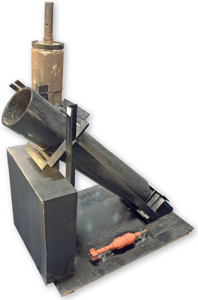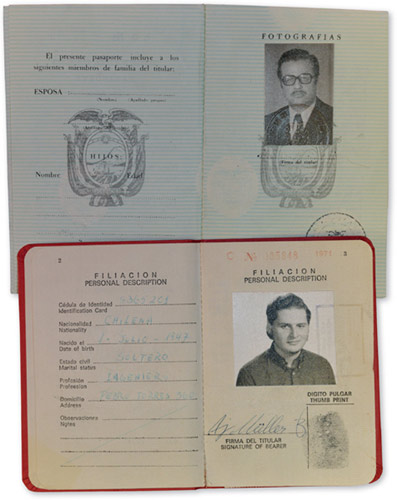
THE MK 10 mortar was used on 7 February 1991 when a van with a hole cut in its roof was parked in a side street off Whitehall, with a timing device set to fire three mortar bombs. The driver of the van then left the scene on the back of a waiting motorcycle. There had been snow and when that was cleared, yellow markings were found that seemed to indicate the position planned for parking the van. A few minutes later, three mortars were fired from the van. The second and third mortars failed to explode, landing in a grassed area behind Downing Street and by the Mountbatten memorial. The first exploded in the garden of No. 10 Downing Street whilst a Cabinet meeting chaired by Prime Minister John Major was in progress, breaking windows and scattering large amounts of debris. The mortars travelled 187m, 207m and 240m respectively. Four people, none of them members of the government, were slightly injured in the attack. The Cabinet meeting resumed at another location.
It was the first time that the Provisional IRA had used mortar bombs on mainland Britain. The preparations for the attack had been made well in advance, and had been set up with the assistance of terrorists who were familiar with the mortar trajectories. Those who drove the van on the day, at greater risk of arrest, were regarded as more expendable. The terrorists went to great lengths to disguise the true identity of the van by grinding away the identification marks on the engine and bodywork, but the registration number was traced: the van had been purchased at an auction in Canterbury on 24 January 1991 by two men who paid £1,060 cash.

1991
Large Mk 10 mortar device, with smaller, different mortar also shown
The commander of the Anti-Terrorist Branch at the time was George Churchill-Coleman.
![]()
Three years later, on Wednesday, 9 March 1994, another form of mortar attack was used when a Mk 6 mortar launch platform was found in a Nissan Micra that was burning fiercely in Bath Road, near Heathrow airport, in a parking area near the Excelsior hotel. One hour earlier a coded message had been given anonymously to Sky television, warning that the whole Heathrow area should be cleared because of a large number of bombs due to be detonated. The platform, now in the museum, had four 780mm tubes welded to a heavy metal base plate and pointing through the rear window of the car. The position of the car directed the mortar tubes towards Terminal 1 at the airport. Three mortar bombs and part of a fourth were found within the runway perimeter about 1,000m from the car, but all had failed to explode. It was the first of a series of such attacks that took place over the next few days.
The following evening, a series of coded calls culminated in a set of explosions that were heard near the Hilton hotel at Heathrow. Four mortar bombs were found near Terminal 4, the launch site being hidden in bramble bushes on wasteland 700m away. On the Sunday morning, another series of coded warnings were followed by four mortars landing in and around Terminal 4. They had been launched from a hole in the ground with a concrete base, which had then been covered over with wood and turf.
The garage in north-west London in which the mortars had been prepared had been rented by Michael Gallagher, who was arrested when he requested the return of his £50 deposit on 28 October 1996. He was convicted of conspiracy to cause explosions, was sentenced to twenty years’ imprisonment in 1998 and was released in 1999 under the terms of the Belfast Good Friday Agreement.
![]()
Timing devices were part of the incriminating evidence – along with 45kg of Semtex, detonators, six Romanian AKM assault rifles, ammunition and other material – found in a lock-up garage and the Northolt house of 37-year-old James Joseph Canning and Ethel Audrey Lamb, who were arrested. On 13 April 1992, the police raided their home as the result of Operation Catnip that had linked Canning to Bride Lane in London where he left a briefcase that later exploded. When he was arrested, Canning had a Smith & Wesson revolver in his waistband. Ethel Lamb admitted that Canning had acted as quartermaster supplying various bombs that had been detonated over the previous year, and one of the recovered rifles had been used in an attempt to murder the Governor of Gibraltar. Canning pleaded guilty to conspiracy to cause explosions and was sentenced to thirty years’ imprisonment. Ethel Lamb was imprisoned for three years.
![]()
A collection of tools and other paraphernalia, such as spades, compasses and maps (some of which might have had innocent purposes) was revealed in its true light in Operation Airlines when police, under the directions of Commander John Grieve, raided an address in Woodbury Street, Tooting, on 15 July 1996 and found explosive devices primed and ready for being planted. The plot had been to attack electricity installations in the London area and to disrupt power supplies. The police surveillance operation provided evidence that resulted in Gerard Hanratty, Donal Gannon, Patrick Martin, Robert Marrow, Francis Rafferty and John Crawley (all members of PIRA) being sentenced to thirty-five years’ imprisonment.

1972–80
Passports used by ‘Carlos the Jackal’